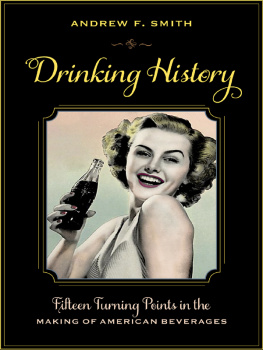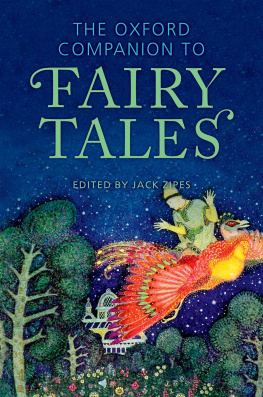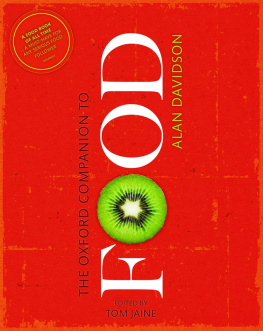Andrew F. Smith - The Oxford Companion to American Food and Drink (Oxford Companions)
Here you can read online Andrew F. Smith - The Oxford Companion to American Food and Drink (Oxford Companions) full text of the book (entire story) in english for free. Download pdf and epub, get meaning, cover and reviews about this ebook. year: 2007, publisher: Oxford University Press, genre: Art. Description of the work, (preface) as well as reviews are available. Best literature library LitArk.com created for fans of good reading and offers a wide selection of genres:
Romance novel
Science fiction
Adventure
Detective
Science
History
Home and family
Prose
Art
Politics
Computer
Non-fiction
Religion
Business
Children
Humor
Choose a favorite category and find really read worthwhile books. Enjoy immersion in the world of imagination, feel the emotions of the characters or learn something new for yourself, make an fascinating discovery.

- Book:The Oxford Companion to American Food and Drink (Oxford Companions)
- Author:
- Publisher:Oxford University Press
- Genre:
- Year:2007
- Rating:4 / 5
- Favourites:Add to favourites
- Your mark:
- 80
- 1
- 2
- 3
- 4
- 5
The Oxford Companion to American Food and Drink (Oxford Companions): summary, description and annotation
We offer to read an annotation, description, summary or preface (depends on what the author of the book "The Oxford Companion to American Food and Drink (Oxford Companions)" wrote himself). If you haven't found the necessary information about the book — write in the comments, we will try to find it.
The Oxford Companion to American Food and Drink (Oxford Companions) — read online for free the complete book (whole text) full work
Below is the text of the book, divided by pages. System saving the place of the last page read, allows you to conveniently read the book "The Oxford Companion to American Food and Drink (Oxford Companions)" online for free, without having to search again every time where you left off. Put a bookmark, and you can go to the page where you finished reading at any time.
Font size:
Interval:
Bookmark:
The Oxford Companion to American Food and Drink
Editorial Board
Gary Allen
Food Writer, Kingston, New York
Warren Belasco
University of Maryland, Baltimore County
Joseph M. Carlin
Founder and Owner, Food Heritage Press, Ipswich, Massachusetts
Cara De Silva
Journalist and Independent Scholar, New York City
Meryle Evans
Culinary Historian, New York City
Barbara Haber
Food Historian, Winchester, Massachusetts
Karen Hess
Independent Scholar, New York City
David Karp
Food Writer, Venice, California
Cathy K. Kaufman
Institute of Culinary Education, New York
Bruce Kraig
Roosevelt University, Chicago, Emeritus, and President, Culinary Historians of Chicago
Janice Bluestein Longone
Curator of American Culinary History, Clements Library, University of Michigan
Barry Popik
Independent Scholar, Austin, Texas
Alice Ross
Director, Alice Ross Hearth Studios, Consultant, Author, Teacher, Smithtown, New York
Mark H. Zanger
Independent Scholar, Boston
Edited by Andrew F. Smith


Oxford New York
Auckland Bangkok Buenos Aires Cape Town Chennai
Dar es Salaam Delhi Hong Kong Istanbul Karachi Kolkata
Kuala Lumpur Madrid Melbourne Mexico City Mumbai Nairobi
So Paulo Shanghai Taipei Tokyo Toronto
Copyright 2007 by Oxford University Press, Inc.
Published by Oxford University Press, Inc.
198 Madison Avenue, New York, New York, 10016
http://www.oup.com/us
Oxford is a registered trademark of Oxford University Press
All rights reserved. No part of this publication may be reproduced,
stored in a retrieval system, or transmitted, in any form or by any means,
electronic, mechanical, photocopying, recording, or otherwise,
without the prior permission of Oxford University Press.
Library of Congress Cataloging-in-Publication Data
The Oxford companion to American food and drink / Andrew F. Smith, editor.
p. cm.
Includes bibliographical references and index.
ISBN-13: 9780-19-530796-2 (hardcover : alk. paper)
1. FoodEncyclopedias. 2. Cookery, AmericanEncyclopedias.
3. Food habitsUnited StatesEncyclopedias. I. Smith, Andrew F., 1946
TX349.O94 2007
394.120973dc22
2006032303
9 8 7 6 5 4 3 2 1
Printed in the United States of America
on acid-free paper
THE OXFORD COMPANION TO AMERICAN FOOD AND DRINK
What is American food? Is it traditional foodstuffs, such as maize, beans, squash, domesticated in the Americas? Is it warmed-over British fare, such as meat, potatoes, puddings, and sandwiches? Or perhaps is it special holiday treatsturkey, cranberries, corn on the cob, candied sweet potatoes, or Christmas cookies? Is it ethnic foods brought by continuous waves of immigrantstacos, pizza, spaghetti, and fortune cookiesand bastardized in America? Is it fast foodhamburgers, french fries, pizza, or hot dogs? Or commercial productsLays potato chips, Hershey bars, Campbells soups, Good Humor ice creams, Betty Crocker cake mixes, Minute Maid frozen orange juice, Swanson TV dinners, or Coca-Cola? Or is it the haute cuisine of Americas best restaurants like Delmonicos and Per Se in Manhattan? Perhaps the new, emerging California cuisine la Wolfgang Puck, Alice Waters, Thomas Keller, and Jeremiah Towers is the essence of edible in America? What about those foods discussed in Gourmet, Bon Appetite, or Saveur? Or the cooking programs on PBS or the Food Network? Maybe the foods cited in the more than twenty thousand cookbooks and other food books published annually in the United States are the real thing?
The Oxford Companion to American Food and Drink broadly and eclectically defines American food and drink as the foods and beverages consumed in the United States. It is a smorgasbord foodscape filled with creative entrepreneurs, overworked consumers, well-intentioned reformers, and competing culinary elites. It is composed of numerous ingredients, diverse flavors, unique dishes, ever-changing modes of preparation, expanding methods of distribution, and the usual and unusual ways Americans eat. In addition, this Companion examines the underlying processes and broad trends, such as urbanization, industrialization, suburbanization, and globalization, that have determined what Americans eat today.
Food has profoundly affected the American continent, beginning in prehistoric times, when Old World hunters came to the New World seeking big game, to modern times, in which American agriculture helps feed the world. Food has profoundly shaped our society: It has influenced population growth and migrations, dictated economic and political changes, expanded commerce, inspired poems and literature, and precipitated the evolution and invention of certain lifestyles. The desire for food served at particular times and in specific ways has caused the creation of new technologies, from the earliest canning efforts to microwave ovens. Food was at the core of American medicine in the nineteenth century, and dietary concerns remain an important component of medical practice today. Food has also been an important weapon in war. Well-fed armies usually defeat hungry ones, as illustrated by the Civil War; conversely, wars have altered our eating habits by introducing new foods and processes and by creating new uses for old foods. After the Civil War, for instance, peanuts went from a slave food to one of Americas first national snack foods, and canned food went from an expensive luxury to a low-cost everyday product. Chocolate bars became popular due to military procurement policies during World War I. And Coca-Cola marched along with the American military to the farthest reaches of the globe during World War II.
Beyond nutritional value, food has psychological and emotional value. Consuming foods and beverages gratifies pleasure and relieves stress. Depending on the circumstance, with whom one eats and under what conditions could be a family get-together, a romantic encounter, a business matter, a status enhancer, or a religious experience. Finally, food is security and power: Those who have it survive and thrive; those who dont languish and die.
Food is Americas most important business and its largest export. Never before in the history of the world has one group of people had so much influence over the culinary lives of others. American food surpluses have saved millions of lives in other nations, and American farm subsidies and tariffs have caused economic havoc and political upheaval in Africa and Southeast Asia. Other countries are rapidly expanding their exports to the United States, and American food corporations are rapidly expanding abroad. American fast food companies are increasing their operations in other countries while they are contracting their operations in the United States. Some of these corporations are at the forefront of genetic engineering research and applications. As a consequence of this technology, the world may either be on the verge of a great culinary revolution or perhaps a genetic catastrophe.
The idea of an American cuisine is not a new phenomenon. Although the dominant culinary style in the original thirteen colonies was English, Americans adapted to new environmental conditions by creating a cuisine entirely their own. In the four centuries since the English colonies were established in North America, American cookery has been greatly modified by climatic and environmental conditions in the New World, the availability of new ingredients, and numerous adoptions and adaptations from the cookery of immigrants from a multitude of nations, cultures, and religions. American food has never stopped changing, and this constant innovation is perhaps its hallmark. The pace of culinary change in America and the world is accelerating, and it will likely continue to do so in the future.
Next pageFont size:
Interval:
Bookmark:
Similar books «The Oxford Companion to American Food and Drink (Oxford Companions)»
Look at similar books to The Oxford Companion to American Food and Drink (Oxford Companions). We have selected literature similar in name and meaning in the hope of providing readers with more options to find new, interesting, not yet read works.
Discussion, reviews of the book The Oxford Companion to American Food and Drink (Oxford Companions) and just readers' own opinions. Leave your comments, write what you think about the work, its meaning or the main characters. Specify what exactly you liked and what you didn't like, and why you think so.










